Pharmacology Report: Monoclonal Antibodies in Clinical Applications
VerifiedAdded on 2023/06/04
|5
|1239
|319
Report
AI Summary
This report provides a comprehensive overview of monoclonal antibodies (mAbs) in pharmacology, tracing their evolution from scientific tools to vital therapeutic agents. It highlights the advancements in humanized mAbs and antibody-drug conjugates, emphasizing their approval for various disease treatments. The report categorizes mAbs based on their mechanism of action, distinguishing between those that modulate immune responses and those targeting non-immune cells. It details the historical development of mAbs, including the initial murine mAbs, the subsequent development of humanized and chimeric mAbs, and the application of modern technologies like ADCs and bispecific antibodies. The report underscores the impact of mAbs in cancer diagnosis, detection, and therapy, citing blockbuster medicines like rituximab and bevacizumab. Furthermore, it discusses the potential of mAbs in treating various human diseases, including immune disorders, and their applications in areas like kidney transplants, breast cancer, and Crohn's disease. The report concludes by referencing key literature and highlighting the ongoing research and future prospects for personalized medical treatments using mAbs.
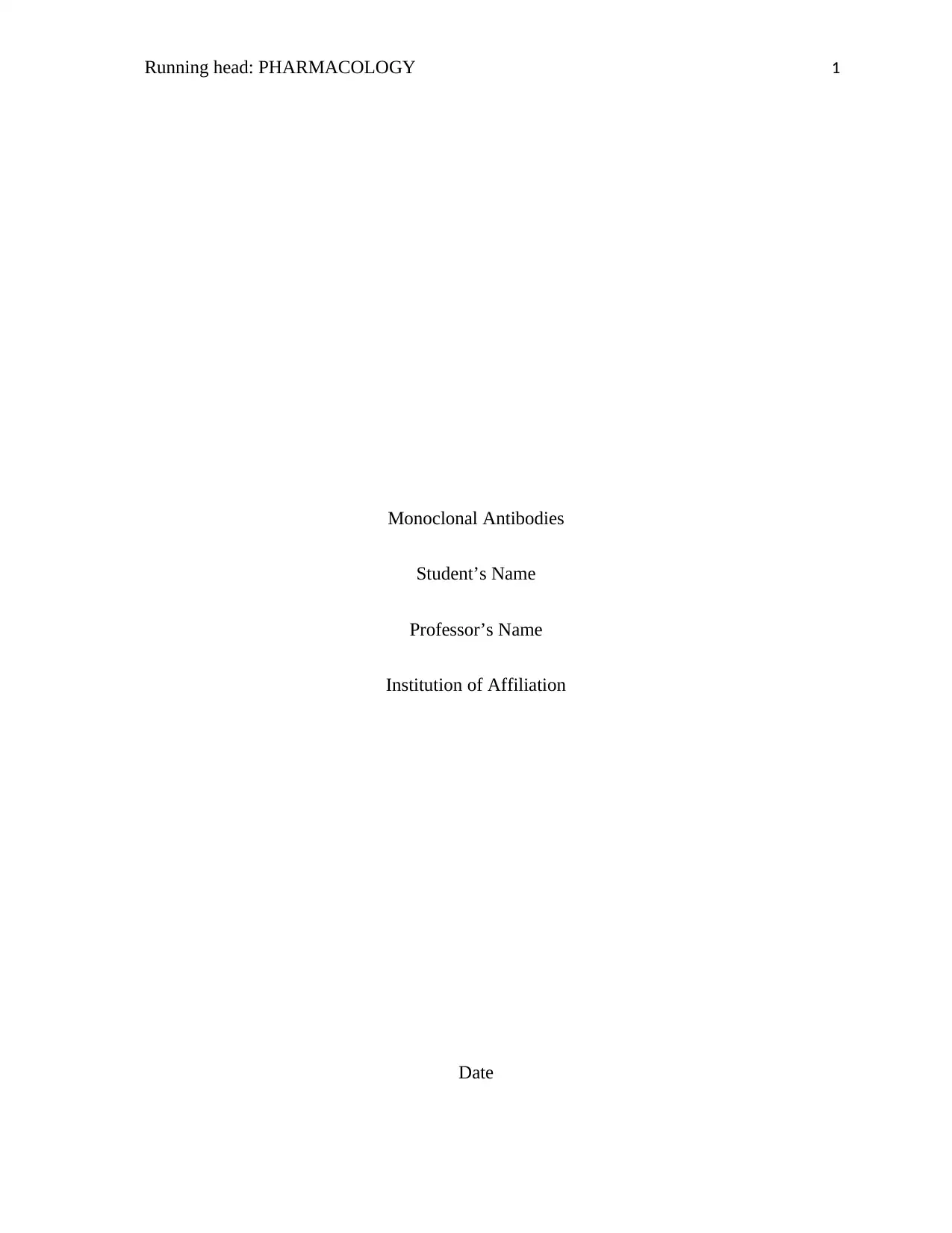
Running head: PHARMACOLOGY 1
Monoclonal Antibodies
Student’s Name
Professor’s Name
Institution of Affiliation
Date
Monoclonal Antibodies
Student’s Name
Professor’s Name
Institution of Affiliation
Date
Paraphrase This Document
Need a fresh take? Get an instant paraphrase of this document with our AI Paraphraser
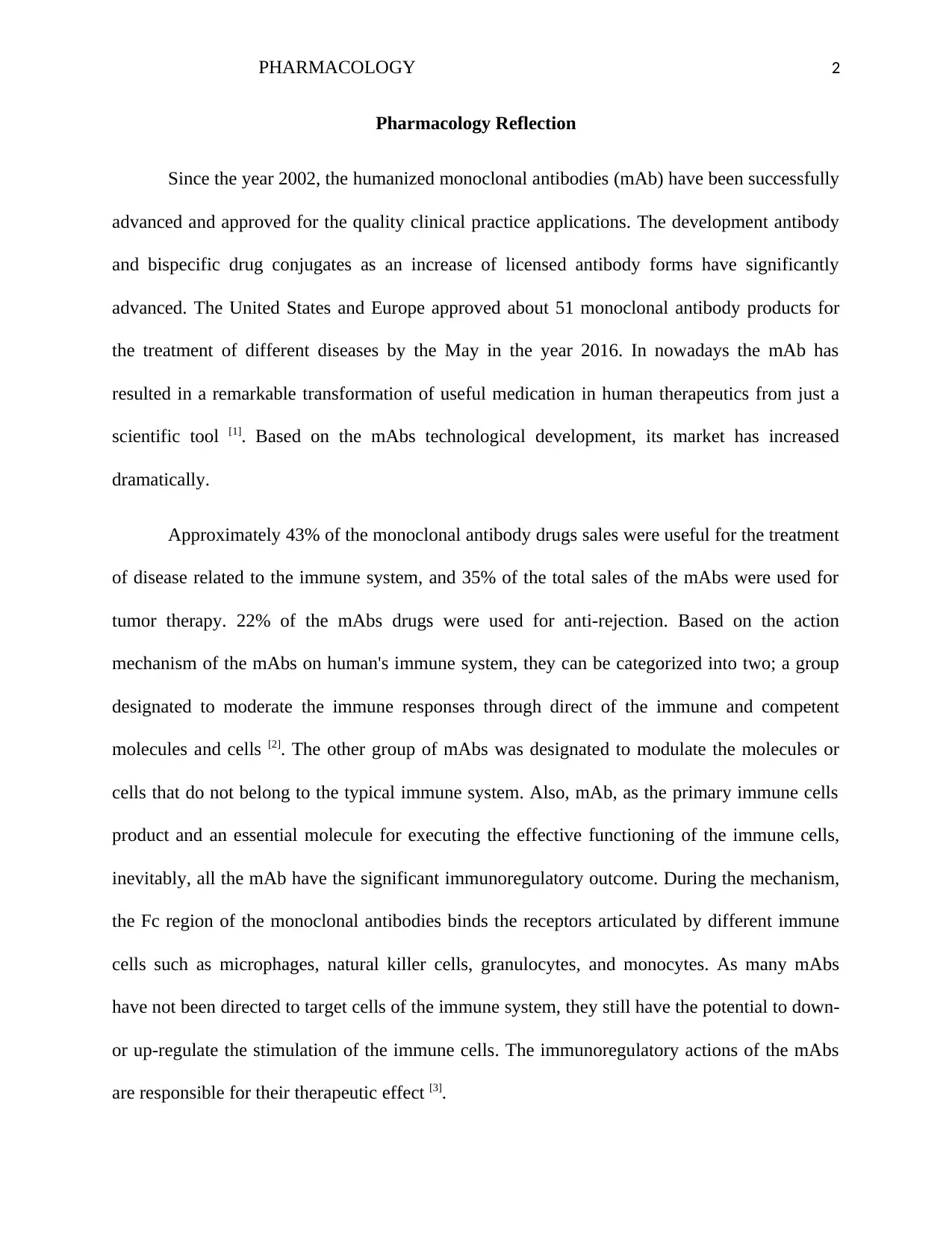
PHARMACOLOGY 2
Pharmacology Reflection
Since the year 2002, the humanized monoclonal antibodies (mAb) have been successfully
advanced and approved for the quality clinical practice applications. The development antibody
and bispecific drug conjugates as an increase of licensed antibody forms have significantly
advanced. The United States and Europe approved about 51 monoclonal antibody products for
the treatment of different diseases by the May in the year 2016. In nowadays the mAb has
resulted in a remarkable transformation of useful medication in human therapeutics from just a
scientific tool [1]. Based on the mAbs technological development, its market has increased
dramatically.
Approximately 43% of the monoclonal antibody drugs sales were useful for the treatment
of disease related to the immune system, and 35% of the total sales of the mAbs were used for
tumor therapy. 22% of the mAbs drugs were used for anti-rejection. Based on the action
mechanism of the mAbs on human's immune system, they can be categorized into two; a group
designated to moderate the immune responses through direct of the immune and competent
molecules and cells [2]. The other group of mAbs was designated to modulate the molecules or
cells that do not belong to the typical immune system. Also, mAb, as the primary immune cells
product and an essential molecule for executing the effective functioning of the immune cells,
inevitably, all the mAb have the significant immunoregulatory outcome. During the mechanism,
the Fc region of the monoclonal antibodies binds the receptors articulated by different immune
cells such as microphages, natural killer cells, granulocytes, and monocytes. As many mAbs
have not been directed to target cells of the immune system, they still have the potential to down-
or up-regulate the stimulation of the immune cells. The immunoregulatory actions of the mAbs
are responsible for their therapeutic effect [3].
Pharmacology Reflection
Since the year 2002, the humanized monoclonal antibodies (mAb) have been successfully
advanced and approved for the quality clinical practice applications. The development antibody
and bispecific drug conjugates as an increase of licensed antibody forms have significantly
advanced. The United States and Europe approved about 51 monoclonal antibody products for
the treatment of different diseases by the May in the year 2016. In nowadays the mAb has
resulted in a remarkable transformation of useful medication in human therapeutics from just a
scientific tool [1]. Based on the mAbs technological development, its market has increased
dramatically.
Approximately 43% of the monoclonal antibody drugs sales were useful for the treatment
of disease related to the immune system, and 35% of the total sales of the mAbs were used for
tumor therapy. 22% of the mAbs drugs were used for anti-rejection. Based on the action
mechanism of the mAbs on human's immune system, they can be categorized into two; a group
designated to moderate the immune responses through direct of the immune and competent
molecules and cells [2]. The other group of mAbs was designated to modulate the molecules or
cells that do not belong to the typical immune system. Also, mAb, as the primary immune cells
product and an essential molecule for executing the effective functioning of the immune cells,
inevitably, all the mAb have the significant immunoregulatory outcome. During the mechanism,
the Fc region of the monoclonal antibodies binds the receptors articulated by different immune
cells such as microphages, natural killer cells, granulocytes, and monocytes. As many mAbs
have not been directed to target cells of the immune system, they still have the potential to down-
or up-regulate the stimulation of the immune cells. The immunoregulatory actions of the mAbs
are responsible for their therapeutic effect [3].
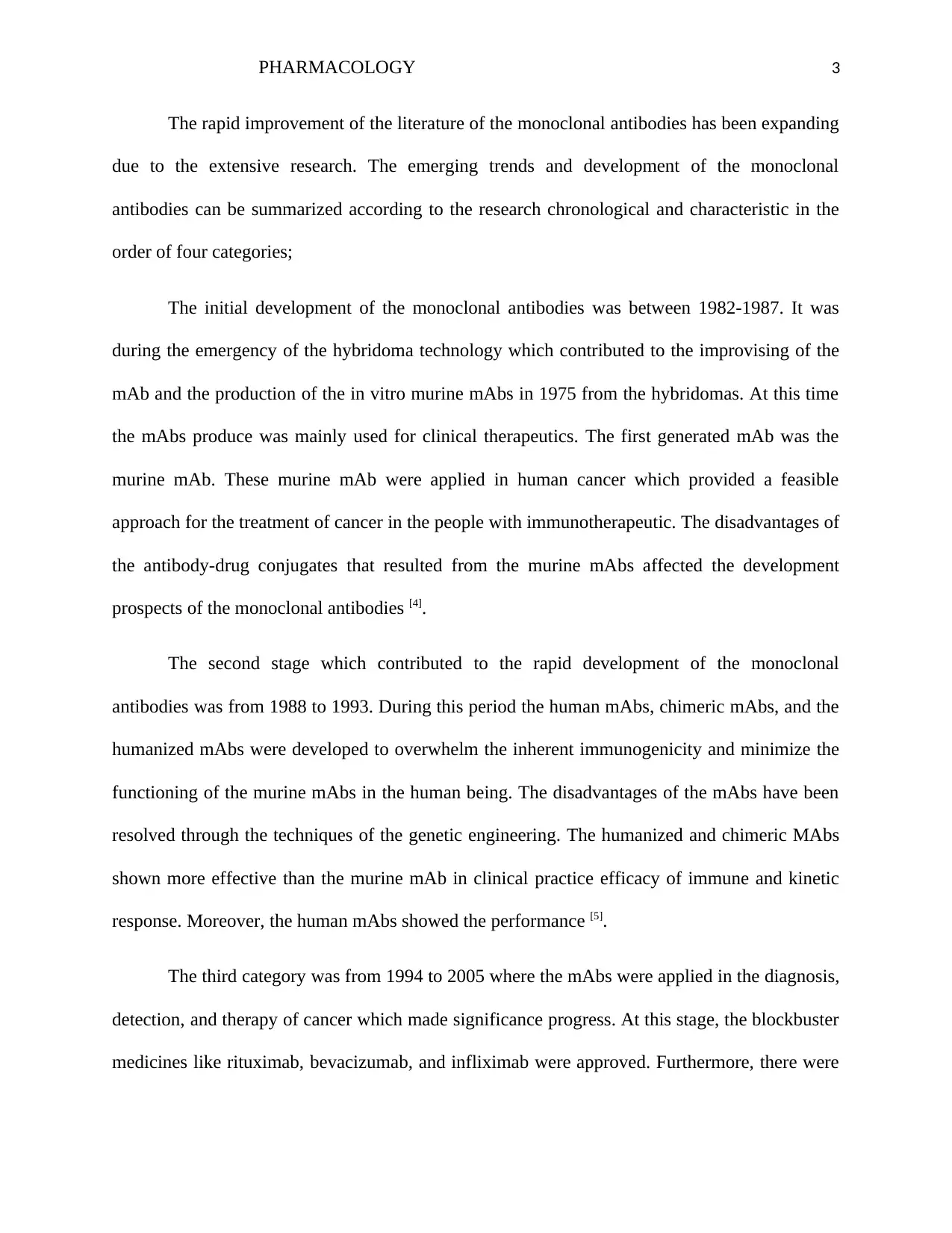
PHARMACOLOGY 3
The rapid improvement of the literature of the monoclonal antibodies has been expanding
due to the extensive research. The emerging trends and development of the monoclonal
antibodies can be summarized according to the research chronological and characteristic in the
order of four categories;
The initial development of the monoclonal antibodies was between 1982-1987. It was
during the emergency of the hybridoma technology which contributed to the improvising of the
mAb and the production of the in vitro murine mAbs in 1975 from the hybridomas. At this time
the mAbs produce was mainly used for clinical therapeutics. The first generated mAb was the
murine mAb. These murine mAb were applied in human cancer which provided a feasible
approach for the treatment of cancer in the people with immunotherapeutic. The disadvantages of
the antibody-drug conjugates that resulted from the murine mAbs affected the development
prospects of the monoclonal antibodies [4].
The second stage which contributed to the rapid development of the monoclonal
antibodies was from 1988 to 1993. During this period the human mAbs, chimeric mAbs, and the
humanized mAbs were developed to overwhelm the inherent immunogenicity and minimize the
functioning of the murine mAbs in the human being. The disadvantages of the mAbs have been
resolved through the techniques of the genetic engineering. The humanized and chimeric MAbs
shown more effective than the murine mAb in clinical practice efficacy of immune and kinetic
response. Moreover, the human mAbs showed the performance [5].
The third category was from 1994 to 2005 where the mAbs were applied in the diagnosis,
detection, and therapy of cancer which made significance progress. At this stage, the blockbuster
medicines like rituximab, bevacizumab, and infliximab were approved. Furthermore, there were
The rapid improvement of the literature of the monoclonal antibodies has been expanding
due to the extensive research. The emerging trends and development of the monoclonal
antibodies can be summarized according to the research chronological and characteristic in the
order of four categories;
The initial development of the monoclonal antibodies was between 1982-1987. It was
during the emergency of the hybridoma technology which contributed to the improvising of the
mAb and the production of the in vitro murine mAbs in 1975 from the hybridomas. At this time
the mAbs produce was mainly used for clinical therapeutics. The first generated mAb was the
murine mAb. These murine mAb were applied in human cancer which provided a feasible
approach for the treatment of cancer in the people with immunotherapeutic. The disadvantages of
the antibody-drug conjugates that resulted from the murine mAbs affected the development
prospects of the monoclonal antibodies [4].
The second stage which contributed to the rapid development of the monoclonal
antibodies was from 1988 to 1993. During this period the human mAbs, chimeric mAbs, and the
humanized mAbs were developed to overwhelm the inherent immunogenicity and minimize the
functioning of the murine mAbs in the human being. The disadvantages of the mAbs have been
resolved through the techniques of the genetic engineering. The humanized and chimeric MAbs
shown more effective than the murine mAb in clinical practice efficacy of immune and kinetic
response. Moreover, the human mAbs showed the performance [5].
The third category was from 1994 to 2005 where the mAbs were applied in the diagnosis,
detection, and therapy of cancer which made significance progress. At this stage, the blockbuster
medicines like rituximab, bevacizumab, and infliximab were approved. Furthermore, there were
⊘ This is a preview!⊘
Do you want full access?
Subscribe today to unlock all pages.

Trusted by 1+ million students worldwide
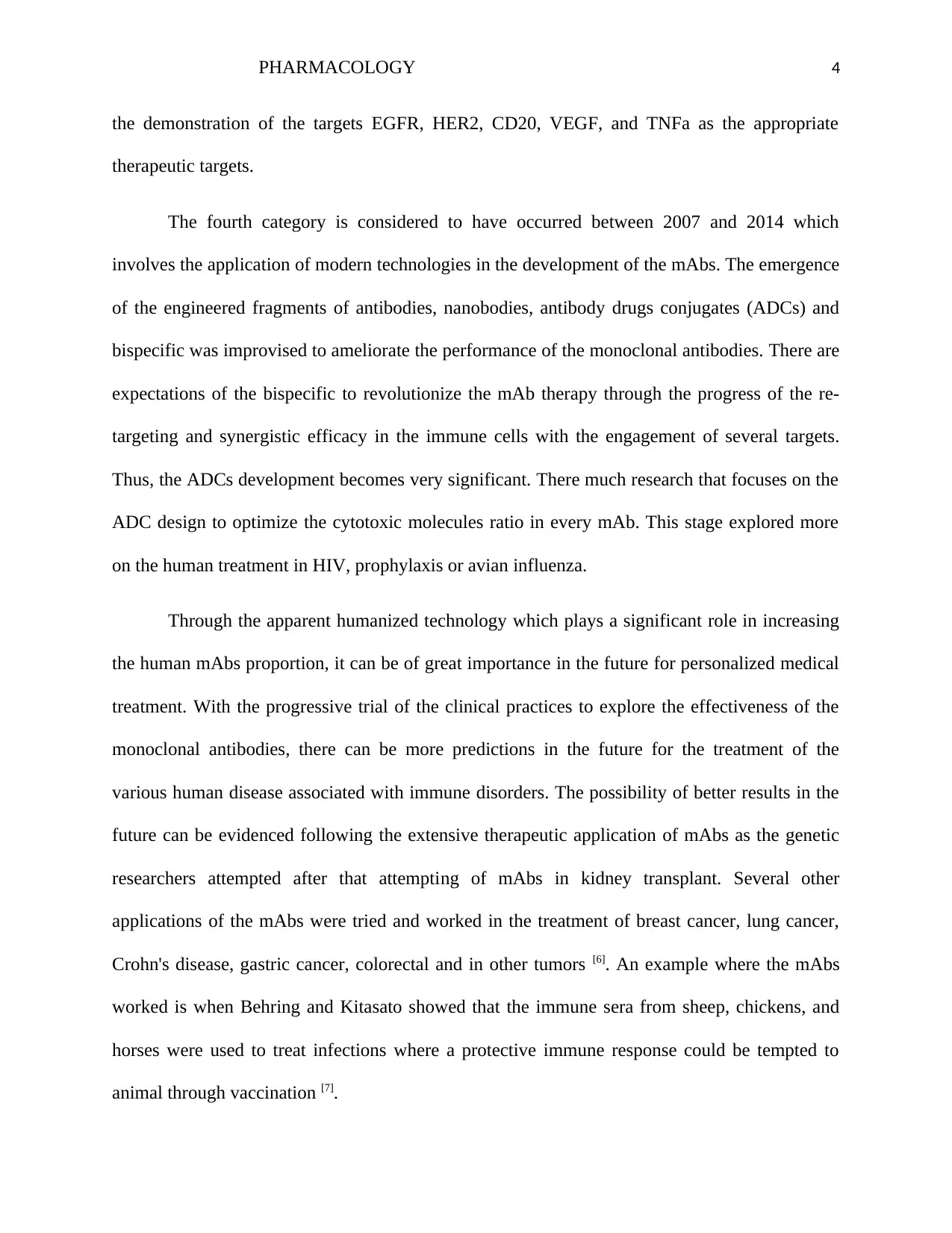
PHARMACOLOGY 4
the demonstration of the targets EGFR, HER2, CD20, VEGF, and TNFa as the appropriate
therapeutic targets.
The fourth category is considered to have occurred between 2007 and 2014 which
involves the application of modern technologies in the development of the mAbs. The emergence
of the engineered fragments of antibodies, nanobodies, antibody drugs conjugates (ADCs) and
bispecific was improvised to ameliorate the performance of the monoclonal antibodies. There are
expectations of the bispecific to revolutionize the mAb therapy through the progress of the re-
targeting and synergistic efficacy in the immune cells with the engagement of several targets.
Thus, the ADCs development becomes very significant. There much research that focuses on the
ADC design to optimize the cytotoxic molecules ratio in every mAb. This stage explored more
on the human treatment in HIV, prophylaxis or avian influenza.
Through the apparent humanized technology which plays a significant role in increasing
the human mAbs proportion, it can be of great importance in the future for personalized medical
treatment. With the progressive trial of the clinical practices to explore the effectiveness of the
monoclonal antibodies, there can be more predictions in the future for the treatment of the
various human disease associated with immune disorders. The possibility of better results in the
future can be evidenced following the extensive therapeutic application of mAbs as the genetic
researchers attempted after that attempting of mAbs in kidney transplant. Several other
applications of the mAbs were tried and worked in the treatment of breast cancer, lung cancer,
Crohn's disease, gastric cancer, colorectal and in other tumors [6]. An example where the mAbs
worked is when Behring and Kitasato showed that the immune sera from sheep, chickens, and
horses were used to treat infections where a protective immune response could be tempted to
animal through vaccination [7].
the demonstration of the targets EGFR, HER2, CD20, VEGF, and TNFa as the appropriate
therapeutic targets.
The fourth category is considered to have occurred between 2007 and 2014 which
involves the application of modern technologies in the development of the mAbs. The emergence
of the engineered fragments of antibodies, nanobodies, antibody drugs conjugates (ADCs) and
bispecific was improvised to ameliorate the performance of the monoclonal antibodies. There are
expectations of the bispecific to revolutionize the mAb therapy through the progress of the re-
targeting and synergistic efficacy in the immune cells with the engagement of several targets.
Thus, the ADCs development becomes very significant. There much research that focuses on the
ADC design to optimize the cytotoxic molecules ratio in every mAb. This stage explored more
on the human treatment in HIV, prophylaxis or avian influenza.
Through the apparent humanized technology which plays a significant role in increasing
the human mAbs proportion, it can be of great importance in the future for personalized medical
treatment. With the progressive trial of the clinical practices to explore the effectiveness of the
monoclonal antibodies, there can be more predictions in the future for the treatment of the
various human disease associated with immune disorders. The possibility of better results in the
future can be evidenced following the extensive therapeutic application of mAbs as the genetic
researchers attempted after that attempting of mAbs in kidney transplant. Several other
applications of the mAbs were tried and worked in the treatment of breast cancer, lung cancer,
Crohn's disease, gastric cancer, colorectal and in other tumors [6]. An example where the mAbs
worked is when Behring and Kitasato showed that the immune sera from sheep, chickens, and
horses were used to treat infections where a protective immune response could be tempted to
animal through vaccination [7].
Paraphrase This Document
Need a fresh take? Get an instant paraphrase of this document with our AI Paraphraser
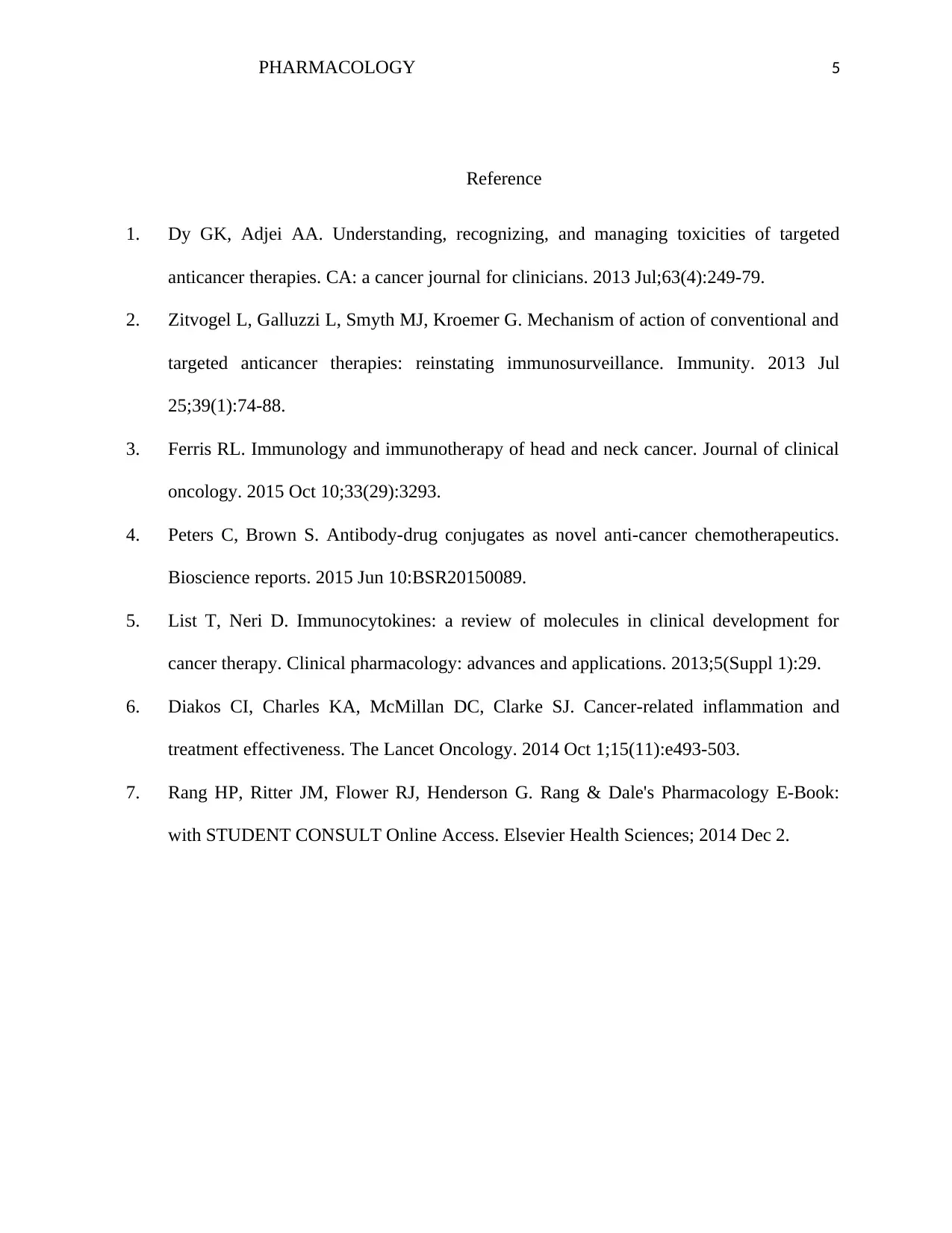
PHARMACOLOGY 5
Reference
1. Dy GK, Adjei AA. Understanding, recognizing, and managing toxicities of targeted
anticancer therapies. CA: a cancer journal for clinicians. 2013 Jul;63(4):249-79.
2. Zitvogel L, Galluzzi L, Smyth MJ, Kroemer G. Mechanism of action of conventional and
targeted anticancer therapies: reinstating immunosurveillance. Immunity. 2013 Jul
25;39(1):74-88.
3. Ferris RL. Immunology and immunotherapy of head and neck cancer. Journal of clinical
oncology. 2015 Oct 10;33(29):3293.
4. Peters C, Brown S. Antibody-drug conjugates as novel anti-cancer chemotherapeutics.
Bioscience reports. 2015 Jun 10:BSR20150089.
5. List T, Neri D. Immunocytokines: a review of molecules in clinical development for
cancer therapy. Clinical pharmacology: advances and applications. 2013;5(Suppl 1):29.
6. Diakos CI, Charles KA, McMillan DC, Clarke SJ. Cancer-related inflammation and
treatment effectiveness. The Lancet Oncology. 2014 Oct 1;15(11):e493-503.
7. Rang HP, Ritter JM, Flower RJ, Henderson G. Rang & Dale's Pharmacology E-Book:
with STUDENT CONSULT Online Access. Elsevier Health Sciences; 2014 Dec 2.
Reference
1. Dy GK, Adjei AA. Understanding, recognizing, and managing toxicities of targeted
anticancer therapies. CA: a cancer journal for clinicians. 2013 Jul;63(4):249-79.
2. Zitvogel L, Galluzzi L, Smyth MJ, Kroemer G. Mechanism of action of conventional and
targeted anticancer therapies: reinstating immunosurveillance. Immunity. 2013 Jul
25;39(1):74-88.
3. Ferris RL. Immunology and immunotherapy of head and neck cancer. Journal of clinical
oncology. 2015 Oct 10;33(29):3293.
4. Peters C, Brown S. Antibody-drug conjugates as novel anti-cancer chemotherapeutics.
Bioscience reports. 2015 Jun 10:BSR20150089.
5. List T, Neri D. Immunocytokines: a review of molecules in clinical development for
cancer therapy. Clinical pharmacology: advances and applications. 2013;5(Suppl 1):29.
6. Diakos CI, Charles KA, McMillan DC, Clarke SJ. Cancer-related inflammation and
treatment effectiveness. The Lancet Oncology. 2014 Oct 1;15(11):e493-503.
7. Rang HP, Ritter JM, Flower RJ, Henderson G. Rang & Dale's Pharmacology E-Book:
with STUDENT CONSULT Online Access. Elsevier Health Sciences; 2014 Dec 2.
1 out of 5
Related Documents
Your All-in-One AI-Powered Toolkit for Academic Success.
+13062052269
info@desklib.com
Available 24*7 on WhatsApp / Email
![[object Object]](/_next/static/media/star-bottom.7253800d.svg)
Unlock your academic potential
Copyright © 2020–2025 A2Z Services. All Rights Reserved. Developed and managed by ZUCOL.





